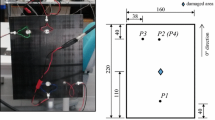Abstract
This study aimed to evaluate the feasibility and usefulness of using the signal created by the impact force after the first impact of an object and subsequent impact of rebounds to evaluate the concrete’s compressive strength non-destructively. Three distinct materials (steel, concrete, and wood) were tested to compare the compressive strengths and signal response using a developed device. The test results demonstrated that the compressive strength of different materials could be effectively represented using the impact force response signals. Following the test results, field case studies were conducted on three different structures. The studies also showed a direct correlation between the impact force response signal and the compressive strength of concrete. Based on the study findings, the total impact force signal energy, which was determined by integrating the impact force response signal, could be used to non-destructively evaluate the compressive strength of concrete materials.
Similar content being viewed by others
References
ASTM C1074 (2021) Standard practice for estimating concrete strength by the maturity method. American Society for Testing and Materials, West Conshohocken, PA
ASTM C803 (2019) Standard test method for penetration resistance of hardened concrete. American Society for Testing and Materials, West Conshohocken, PA
ASTM C805-13 (2013) Standard test method for rebound number of hardened concrete. American Society for Testing and Materials, West Conshohocken, PA
Aydin F, Saribiyik M (2010) Correlation between schmidt hammer and destructive compressions testing for concretes in existing buildings. Scientific Research and Essays 5(13):1644–1648
Carino NJ, Sansalone M (1984) Pulse-echo method for flaw detection in concrete. NBS Technical Note 1199, U.S. Dept. of Commerce/National Bureau of Standards 34
Crawford GI (1997) Guide to nondestructive testing of concrete. Report No. FHWA-SA97–105, Federal Highway Administration, Washington, DC, 1
FHWA (1997) Guide to nondestructive testing of concrete. Federal Highway Administration, FHWA-SA-97-105 written by G.I. Crawford, 1–58
IAEA (2002) Guidebook on non-destructive testing of concrete structures. International Atomic Energy Agency, Training course series No. 17, Vienna, Austria, 1–231
Kahraman S (2001) Evaluation of simple methods for assessing the uniaxial compressive strength of rock. International Journal of Rock Mechanics and Mining Sciences 38(7):981–994, DOI: https://doi.org/10.1016/S1365-1609(01)00039-9
Malhotra VM (1991) Surface hardness methods. Handbook on Nondestructive Testing of Concrete, CRC Press, Inc., Boca Raton, FL, 1–17
Naik TR, Malhotra VM (1991) The ultra-sonic pulse velocity method. Handbook on Nondestructive Testing of Concrete, CRC Press, Inc., Boca Raton, FL, 169–202
Patil NR, Patil JR (2008) Non-destructive testing (NDT) advantages and limitations. SRES College of Engineering, Kopargaon, Maharashtra, 71–78
Popovics S, Popovics JS (1992) A critique of the ultrasonic pulse velocity method for testing concrete. Presented at the Structures Congress, San Antonio, TX, April 13#x2013;15, American Society of Civil Engineers, Reston, VA, 94–103
Shalabi FI, Cording EJ, Al-Hattamleh OH (2007) Estimation of rock engineering properties using hardness tests. Engineering Geology 90(3–4):138–147, DOI: https://doi.org/10.1016/J.ENGGEO.2006.12.006
Son M, Kim M (2017a) Development and validation of an NDT based on total sound signal energy. ASTM Journal of Testing and Evaluation 47(1):87–103, DOI: https://doi.org/10.1520/JTE20170136
Son M, Kim M (2017b) Estimation of the compressive strength of intact rock using non-destructive testing method based on total sound signal energy. Geotechnical Testing Journal 40(4):643–657, DOI: https://doi.org/10.1520/GTJ20160164
Son M, Sung J (2023) Estimation of nondestructive compressive strength of concrete using impact force response signal. ASTM Journal of Testing and Evaluation 51(5):3014–3022, DOI: https://doi.org/10.1520/JTE20220376
Acknowledgments
This work is supported by the Korea Agency for Infrastructure Technology Advancement (KAIA) grant funded by the Ministry of Land, Infrastructure and Transport (Grant 21CTAP-C153174-03).
Author information
Authors and Affiliations
Corresponding author
Rights and permissions
About this article
Cite this article
Son, M., Jeong, W. Application of Impact Force Response Signal to Non-destructive Evaluation of Concrete Compressive Strength in Field Structures. KSCE J Civ Eng 28, 2279–2285 (2024). https://doi.org/10.1007/s12205-024-0534-5
Received:
Accepted:
Published:
Issue Date:
DOI: https://doi.org/10.1007/s12205-024-0534-5




